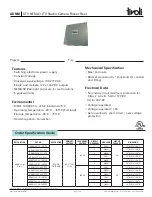
Ways of mounting the transducer
Inside the hull
The transducer can also be mounted inside the hull.
An installation of the transducer inside the hull, and sounding
through the hull, requires a good acoustic contact between the
transducer face and the hull. Build a tank around the transducer
and fill it with a liquid. Oil used in hydraulic systems is a well
suited liquid for this purpose. It contains no gas bubbles and
is non-corrosive.
Typical values of the two way loss are 3 dB for polyester, 6 dB
for aluminium and 10 dB for steel. Hulls made of wood or a
sandwich type with foam in the middle, attenuate the sound so
much that through hull sounding must be regarded as impossible.
The loss varies with the distance between transducer face and
the hull. The best result is obtained when the distance is half a
wavelength. Consult Simrad for advice. In addition to the loss,
the beam pattern is degraded, because a larger area of the hull is
set into vibrations.
Mounting and clamping rings
Circular transducers may be provided with mounting and
clamping rings, or with drawings to allow for local production
of these. The mounting ring is welded to the hole inside the
steel tank, while the clamping ring fits around the edge of the
transducer body. Bolts through the clamping ring into the
mounting ring will then secure the transducer between them.
Note that several transducers use direction guides to allow correct
mounting.
Smooth surface
Mounting screws or bolts must not be extruding from the
acoustic window. Ensure that the surface of the window, the hull
plating and putty around the transducer is as even and smooth as
possible. Obstructions on these surfaces will create problems
with turbulant flow.
Horizontal support bar
Large diameter transducers must be fitted with a horizontal
support bar. This bar can be secured to the mounting ring using
threaded rods.
305265/A
23
Содержание 38-9 - REV B
Страница 2: ......
Страница 6: ...Simrad 38 9 4 305265 A ...
Страница 49: ......
Страница 50: ......
Страница 51: ......
















































